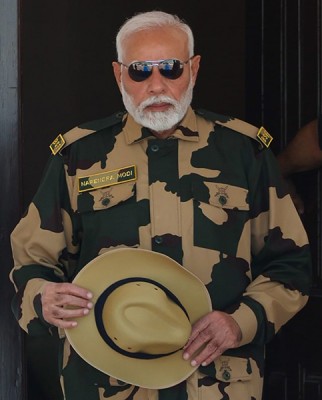
Bihar: Residual Risks
In the preceding month, on June 19, 2016, a CRPF trooper, identified as A. Deka, was killed and two of his colleagues, identified as A.K. Yadav and K. Kakoti, were injured in an IED blast carried out by the Maoists near Bandhu Bigaha village in Aurangabad District. The Maoists triggered the blast when three personnel of the 205th CoBRA unit were riding on two motorcycles on their way to their camp from Bali Pahari locality.
Significantly, on January 11, 2016, while, commenting on the January 8, 2016, encounter in which four Maoists were killed in Bandh Gorya village under Dhibra Police Station area in Aurangabad District, the CPI-Maoist 'central zonal spokesman,' Paramjeet had threatened to avenge the killing. Later on, Maoists pamphlets found from Deo and Dhibra localities read:
"Char ka badla chalis se lenge, Operation Green Hunt band karo, comrade Bihari Yadav, Ratan Yadav, Devki Bhuiyan and Birendra Singh ko sat sat salaam." English translation - [We will take revenge, forty for four, stop Operation Green Hunt, salutations to comrade Bihari Yadav, Ratan Yadav, Devki Bhuiyan and Birendra Singh]
Preliminary investigation of the Aurangabad Maoist attack suggested that the ultras were well prepared for the incident. They had lured the Security Forces (SFs) to the area by telephonically passing on false information. They had also planted hundreds of IEDs in advance, orchestrating a total of 352 land mine blasts on the fateful day. Giving further details about the incident, a senior Police official stated that, initially, the operation was launched on July 17 to arrest Sandeep Yadav, a dreaded Maoist, facing over 80 cases in Bihar and Jharkhand. Later, the Superintendent of Police (SP), Aurangabad District, joined the CoBRA team on July 18 with a team of the District Police and another CoBRA unit. However, it has been learnt that the team was heavily dependent on Global Positioning System (GPS) positioning and feedback but did not take the help of local intelligence.
The Aurangabad incident will go a long way in denting the morale of the SF personnel not just in Bihar but across all theatres of Left Wing Extremist (LWE) conflict in India. The manner in which the Maoists planned and trapped the SFs speaks volume of the hold the ultras enjoy in the region. Aurangabad along with Gaya and Jamui has been the epicentre of Maoist-violence in Bihar.
Aurangabad also finds place among the 35 worst Naxal (LWE) affected Districts in the country. The District's geographical proximity with other Maoist affected Districts of the State and neighbouring Jharkhand makes it one of the preferred shelters for the Maoists in the region. Crucially, Jharkhand has 21 LWE affected Districts out of its total of 24 Districts.
In addition to these incidents of killing, the Maoists have also been involved in other violent activities in 2016, including abduction (one incident in which two persons were abducted), arson (seven incidents), bomb blasts (two occasions), attacks on railway property (one incident), among others, till July 24, in Bihar. During the corresponding period of 2015, the Maoists were involved in three incidents of abduction in which three persons were abducted, and two incidents of arson. No incident of bomb blast or attack on railway property was recorded during 2015.
Despite the alarm over the Aurangabad incident and the other violent activities in the State, the Maoists are under significant pressure. SF consolidation against the Maoists has been significant over a period of time, not just in Bihar but across the country. To overcome this situation they are striking wherever they can. Since October 2015, the Maoists in Chhattisgarh, in particular, have come under tremendous pressure, and the trend seems to be continuing in 2016. Out of the 132 Maoists killed in SF operations across LWE-affected States in India, 72 have been killed in Chhattisgarh alone. Jharkhand, the second most violent State after Chhattisgarh, also consolidated its position against LWEs with 27 rebels eliminated in the first six and half months of 2016. The situation in Odisha, Maharashtra and Bihar, widely varying, saw little violence during the corresponding period. On the other hand, the SF position against the Maoists in Andhra Pradesh and Telangana consolidated further. The Maoist endeavour to create new operational spaces in the trijunction of Tamil Nadu, Kerala and Karnataka, received major jolts after the arrest of key leaders.
According to partial data compiled by the South Asia Terrorism Portal (SATP), 28 persons, including seven civilians, 13 SF personnel and eight Maoists, have been killed in Bihar in 2016 (till July 24), in comparison to seven persons, including three civilians, two SF personnel and two Maoists, killed in the corresponding period of 2015.
Support Our Journalism
We cannot do without you.. your contribution supports unbiased journalism
IBNS is not driven by any ism- not wokeism, not racism, not skewed secularism, not hyper right-wing or left liberal ideals, nor by any hardline religious beliefs or hyper nationalism. We want to serve you good old objective news, as they are. We do not judge or preach. We let people decide for themselves. We only try to present factual and well-sourced news.







